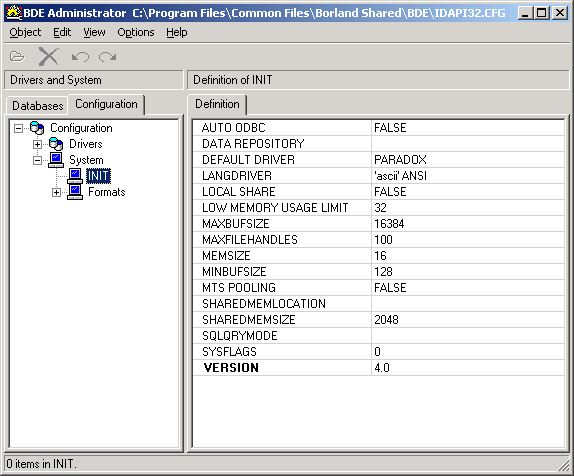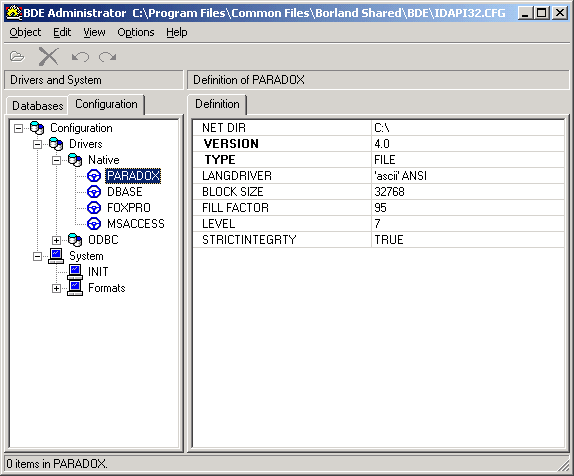
Теперь о правилах ускорения работы BDE (источник - http://bdesupport.com/ ) Ниже приводится несколько сокращенный оригинал статьи с кратким переводом:
1.Tweak the BDE Configuration
One way you may be able to enhance performance when dealing with database on another station or file server is to tweak some of the BDE configuration settings. You can use the Borland-supplied BDEADMIN.EXE utility to change these settings, or you can also use the BDE API and the dbiOpenConfigInfoList function. In our tests, the following settings have been shown to increase BDE performance when accessing Paradox tables across a network:
Setting |
Value |
\System\INIT\LANGDRIVER |
'ascii' ANSI (DBWINUS0) |
\System\INIT\MAXBUFSIZE |
16384 |
\System\INIT\MINBUFSIZE |
128 |
\System\INIT\MAXFILEHANDLES |
100 |

Значения этих параметров (естественно, кроме первого – он должен быть Pdox ANSI Cyrilic ) рекомендуется установить в System-Init BDE
Очень важно установить параметры Level =7 и BlockSize =32768 для драйвера PARADOX . В этом случае достигается максимальная производительность BDE при работе с таблицами PARADOX , и, кроме этого, таблицы этого уровня могут содержать до 2-х миллионов записей.

2. Do not use resource-intensive screen savers on the file server
Make sure your file server is not running a resource-intensive screen saver such as one of the OpenGL screen savers. Whenever possible, choose "Blank Screen" as the screen saver on a file server. Using one of the more "active" screen savers can impede the performance of the server if it's CPU time is being allocated to drawing images rather than file management. We've actually seen an NT 4 file server brought to its proverbial knees when serving up files to a small group of LAN clients because a significant portion of its CPU cycles were being dedicated to drawing an OpenGL screen saver. The same Delphi/BDE/Paradox app performed remarkably well when the server's screen saver was finally switched to "Blank Screen"!
Не используйте на файл-сервере хранители экрана. Пусть себе светится! Особая просьба любителям установки всяких собачек и прочей гадости, которая регулярно вылезает из-за окон программы: все эти приблуды могут сильно задерживать работу компьютера.
3. Properly configure virus checkers running on the workstation or file server
A virus checker may cause processing delays if it is configured to check for changes to all files. This could include your database files, even though they are not really vehicles for viruses. If possible, configure the virus checker to scan only executable files. To determine if the virus checker is contributing to performance issues, disable it temporarily and see if database performance increases.
Настройте свои антивирусы, чтобы они не проверяли все файлы, а только EXE, COM, DLL. В противном случае некоторые особо подозрительные резидентные антивирусы будут регулярно проверять все файлы, в том числе, и на удаленных машинах. Очень сильно тормозят работу антивирусные ревизоры. Лучше вообще отключите их и проверяйте компьютеры регулярно путем запуска режима сканирования файлов когда в сети никто не работает.
4. Upgrade the network to 100mbps NICs, cables, and a switch
Don't scrimp on the network hardware. With the reduced costs of network cards (as with most PC hardware), spending a few extra dollars per card and opting for the 100mbps flavor instead of rhe 10mbps version could mean a significant difference in the throughput of your network (10x), thus improving the response time of the BDE when accessing tables across the network. Additionally, if you're network is using a simple hub, consider upgrading to a switch. A switch redirects packets directly to the correct recipient without broadcasting them to everyone on the network (as hubs do) and clogging the pipes with unnecessary traffic -- traffic that reduces the available bandwidth for the real data that you are trying to pass across the network to the file server and back again.
Владельцам китайского барахла! Покажите это своим "бережливым" руководителям, которые думают, что у них установлена сеть, на которой можно работать:
Устанавливайте качественные 100мб сетевые карты, кабель, коммутаторы (хабы).
Не экономьте на сетевых устройствах.
5. Set Session.PrivateDir to a directory on a local hard drive
The BDE uses the PrivateDir setting to determine where it will create its temporary files. These temporary files include those created by the BDE to hold the results of queries, thus storing them on a local drive will increase performance when working with a resultant dataset from a query. It also protects the files from conflicting with other user's temporary BDE files created while working concurrently against the same tables. Be sure you explicitly set PrivateDir early in your application, otherwise the BDE defaults it to the current directory at the time the BDE is initialized. If your application is being launched from a file server, this could cause your PrivateDir to be located across the network from your local station, which could result in slow access to temporary files.
Это для программистов. Рекомендация устанавливать директорию для временных файлов на локальном диске, чтобы по сети не гонять временные расчетные данные.